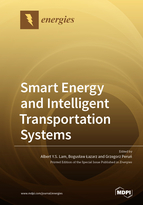Smart Energy and Intelligent Transportation Systems
A special issue of Energies (ISSN 1996-1073). This special issue belongs to the section "E: Electric Vehicles".
Deadline for manuscript submissions: closed (31 December 2021) | Viewed by 13501
Special Issue Editors
Interests: evolutionary computation; optimization techniques; artificial intelligence; smart grid; smart city; intelligent transportation systems
Special Issues, Collections and Topics in MDPI journals
Interests: machine and structure dynamics; vibroacoustic behavior of machines and structures; signal processing
Special Issues, Collections and Topics in MDPI journals
Interests: modeling and simulation of toothed gears; damage modeling and identification; health monitoring; vibroacoustics; signal processing; mechatronics
Special Issues, Collections and Topics in MDPI journals
Special Issue Information
Dear Colleagues,
With the Internet of things and various information and communication technologies, a city can manage its assets in a smarter way, constituting the urban development vision of smart city. This facilitates a more efficient use of physical infrastructure and encourages citizen participation. Smart energy and smart mobility are among the key aspects of the smart city, in which the electric vehicle (EV) is believed to take a key role. EVs are powered by various energy sources or the electricity grid. With proper scheduling, a large fleet of EVs can be charged from charging stations and parking infrastructures. Although the battery capacity of a single EV is small, an aggregation of EVs can perform as a significant power source or load, constituting a vehicle-to-grid (V2G) system. Besides acquiring energy from the grid, in V2G, EVs can also support the grid by providing various demand response and auxiliary services. We can reduce our reliance on fossil fuels and utilize the renewable energy more effectively.
The EV market is growing very quickly, and there will likely be an abundance of EVs running on the road in the near future. EVs are also important building blocks to developing intelligent transportation systems. The self-control of autonomous vehicles (AVs) and the systematic remote control of AV fleets will bring smart energy and intelligent transportation systems into new dimensions.
This Special Issue therefore seeks to contribute to the smart energy and intelligent transportation system agenda through enhanced scientific and multi-disciplinary knowledge to improve performance and deployment by bringing some focus to electric and autonomous vehicles in order to meet technical, socio-economic, and environmental goals, as well as for energy security. We are particularly interested in investigating how smart energy technologies contribute to intelligent transportation systems, and vice versa. We therefore invite papers on innovative technical developments, reviews, and analytical as well as assessment papers from different disciplines which are relevant to the integration of smart energy and mobility. Topics of interest for publication include, but are not limited to:
- Autonomous and cooperative vehicle systems;
- Traffic control and management;
- Mobile Internet, mobility Internet, and Internet of Things;
- Vehicle-to-grid;
- Vehicular energy network;
- Renewable energy;
- Social economics for energy and vehicle platforms;
- Big data for smart energy and mobility;
- Optimization for smart energy and mobility;
- Network architecture for smart energy and mobility integration;
- Deep learning and artificial intelligence;
Prof. Dr. Albert Y.S. Lam
Prof. Dr. Bogusław Łazarz
Prof. Dr. Grzegorz Peruń
Guest Editors
Manuscript Submission Information
Manuscripts should be submitted online at www.mdpi.com by registering and logging in to this website. Once you are registered, click here to go to the submission form. Manuscripts can be submitted until the deadline. All submissions that pass pre-check are peer-reviewed. Accepted papers will be published continuously in the journal (as soon as accepted) and will be listed together on the special issue website. Research articles, review articles as well as short communications are invited. For planned papers, a title and short abstract (about 100 words) can be sent to the Editorial Office for announcement on this website.
Submitted manuscripts should not have been published previously, nor be under consideration for publication elsewhere (except conference proceedings papers). All manuscripts are thoroughly refereed through a single-blind peer-review process. A guide for authors and other relevant information for submission of manuscripts is available on the Instructions for Authors page. Energies is an international peer-reviewed open access semimonthly journal published by MDPI.
Please visit the Instructions for Authors page before submitting a manuscript. The Article Processing Charge (APC) for publication in this open access journal is 2600 CHF (Swiss Francs). Submitted papers should be well formatted and use good English. Authors may use MDPI's English editing service prior to publication or during author revisions.
Keywords
- electric vehicles
- autonomous vehicles
- vehicle-to-grid
- renewable energy
- artificial intelligence








